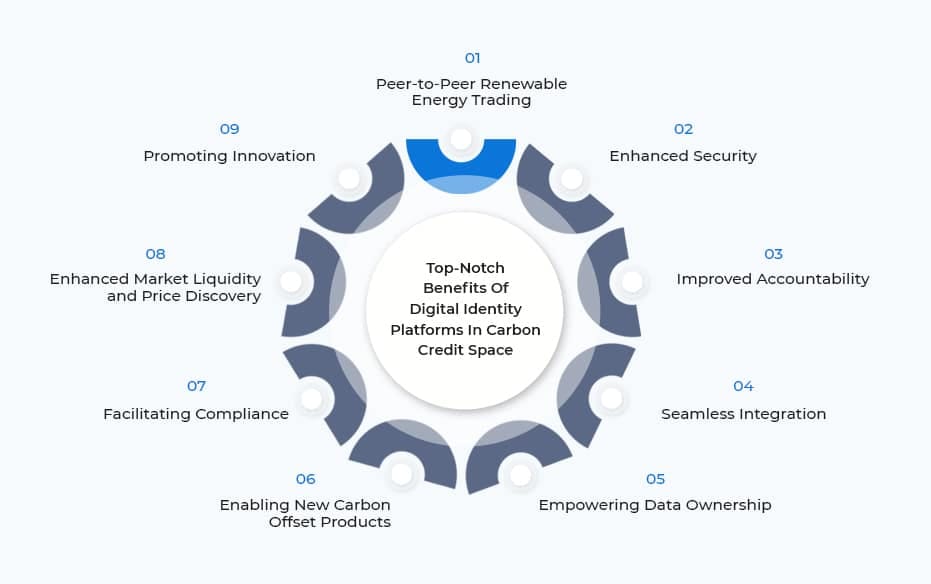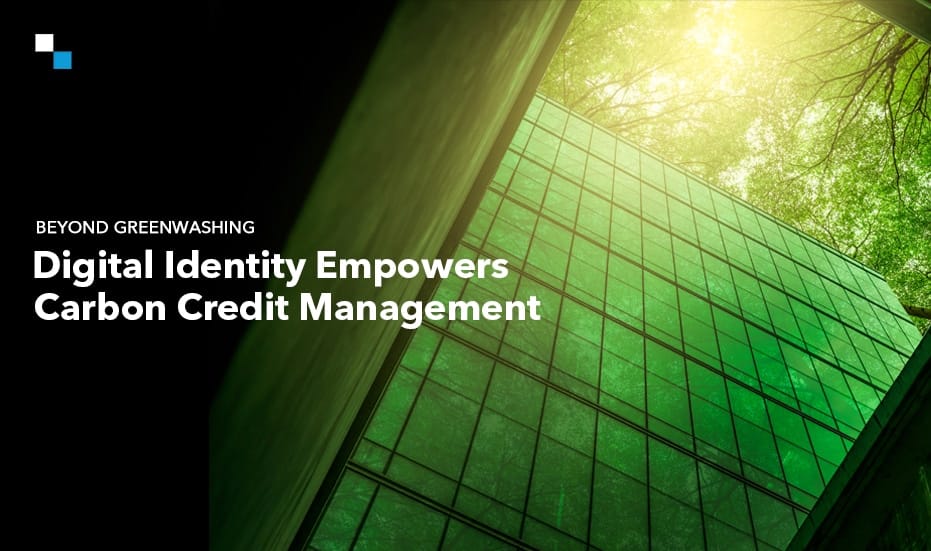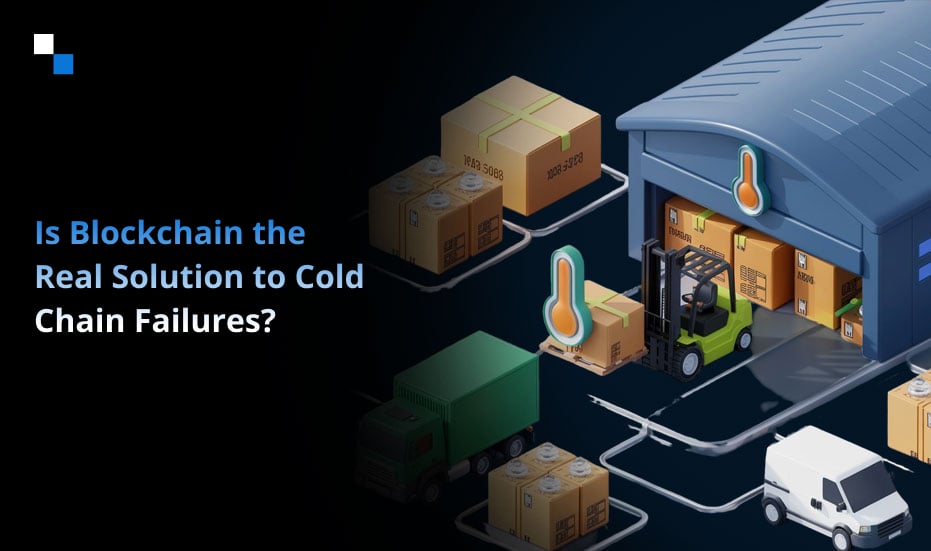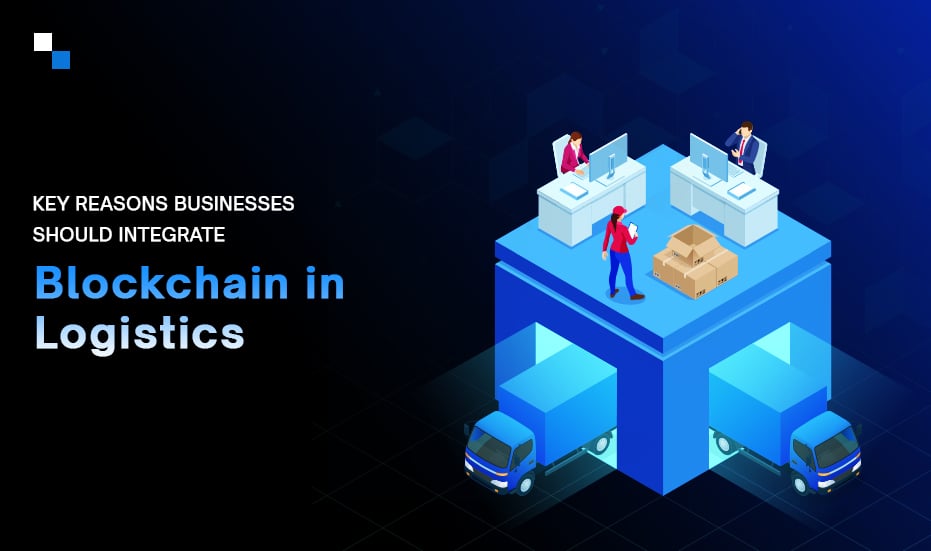
How Virtual Reality with Real Estate Metaverse is Transforming The Business?
March 1, 2024
How To Create Stable Coin To Mitigate Market Volatility
March 4, 2024The global carbon credit market is poised for explosive growth, with estimates predicting it could reach a staggering $1.6 trillion by 2028 (MarketsandMarkets, 2023). This surge in demand highlights a pressing need for a more transparent, secure, and efficient system. Enter blockchain identity solutions – the latest trend in carbon credit trading management that promises to unlock significant benefits for both businesses and the environment.
By leveraging the power of blockchain technology to create secure digital identities, we can build a more sustainable future. This article culminates all the information about how digital identity based on popular blockchain networks operates in the carbon credit ecosystem. Moreover, it also allows you to discover how it addresses the challenges of conventional carbon credit management, the perks of leveraging digital ID solutions, the role of DIDs and VCs, and last but not least, the future potential of blockchain technology in the carbon credit space.
Pain Points: Conventional Carbon Credit Trading Management
Conventional carbon credit trading management faces several challenges. However, these challenges can only be overcome by the highly advanced and featured blockchain-based digital identity solutions can potentially address. Let us understand the challenges in depth to bring out solutions via blockchain technology.
- Lack of Transparency and Traceability- The inability to effectively track the origin and ownership of carbon credits leads to a heightened risk of fraudulent activities and double-counting, undermining the credibility of the market.
- Data Integrity Issues- Verifying the accuracy of data related to emission reductions and project details can be a challenging task. This uncertainty regarding the legitimacy of credits creates doubts among stakeholders and may discourage participation.
- High Transaction Costs– The reliance on intermediaries and cumbersome paperwork processes significantly drives up transaction costs. This can deter potential participants, especially smaller businesses and individuals, from engaging in carbon credit trading.
- Limited Accessibility for Smaller Players– The complexity and high costs associated with traditional trading methods pose barriers to entry for smaller entities. As a result, they often find it challenging to participate in the carbon credit market, limiting inclusivity and innovation.
- Standardization Issues- The absence of standardized methodologies for project verification and credit issuance contributes to confusion and undermines trust within the market. This lack of uniformity makes it difficult for stakeholders to compare and assess different projects effectively.
- Verification Bottlenecks- The verification process for carbon credit projects can be slow and resource-intensive. Delays in project approval and credit issuance hinder the timely flow of credits within the market, impacting overall efficiency.
- Security Concerns- Traditional trading systems may be susceptible to data breaches or manipulation, posing significant risks to market integrity. Concerns regarding data security and privacy can deter participants and erode trust in the carbon credit trading ecosystem.
A growing number of creative solutions that put accessibility, efficiency, and transparency first in the management of carbon credit trading are required to address these pain points successfully. Embracing emerging technologies such as digital identity management software and implementing robust verification mechanisms can enhance trust and streamline operations within the market.
Scroll down to explore how enlisting digital identity services for management can be helpful for the entire carbon credit ecosystem.
How Do Digital Identity Solutions Address The Carbon Credit Trading Challenges?
Blockchain-based digital identity management transforms the overall carbon credit trading market by addressing several challenges inherent in conventional systems. Let us explore the various ways in which blockchain is solving the pain points-
- Transparency and Accountability- Blockchain technology ensures transparency in carbon credit trading by creating a tamper-proof ledger where all transactions are recorded. Integration of digital identity solutions ensures that each participant’s identity is verified and tied to their transactions. This linkage enhances accountability, as each credit’s origin and ownership are visible, reducing the potential for fraudulent activities.
- Preventing Double-Counting- Every participant in the carbon credit trading ecosystem can have a unique digital identity attached to their verified credentials. It eliminates the possibility of double-counting credits or engaging in fraudulent activities, as each credit is associated with a specific identity that can be authenticated on the blockchain.
- Streamlined Verification Process- Digital identity platforms can automate the verification process for carbon credit projects. By integrating verified identity information into the blockchain, the authenticity of project claims can be quickly assessed, reducing the need for extensive paperwork and manual verification processes.
- Reduced Transaction Costs– Blockchain technology eliminates the need for intermediaries in carbon credit trading, reducing transaction costs and making trades faster and more efficient. Digital identity solutions further enhance this by providing a secure and efficient means of conducting transactions without the need for costly third-party verification services.
- Democratizing Participation- Blockchain-based digital identity platforms can lower the barriers to entry for small businesses and individuals, enabling a more inclusive market for carbon credit trading. These digital identity platforms empower a wider range of factors to engage in carbon offsetting activities by providing a secure and transparent environment for participation, thereby increasing the overall effectiveness of climate change mitigation efforts.
- Standardization and Consistency- Digital identity solutions can facilitate the establishment of clear protocols and standards for carbon credit trading on the blockchain. By ensuring that all participants adhere to the same set of rules and procedures, these solutions promote trust and consistency in the market, making it easier for stakeholders to transact with confidence and certainty.

Benefits of Digital Identity Solutions in Carbon Credit Trading Space
While blockchain-based digital identities effectively address the challenges of conventional carbon credit trading, their benefits extend far beyond simply solving existing issues. Here’s how these solutions unlock additional value in the carbon credit space-

- Peer-to-Peer Renewable Energy Trading- Digital identity platforms help connect individuals and small businesses directly with renewable energy producers. This fosters local sustainability initiatives and empowers individuals to contribute to a greener grid.
- Enhanced Security– Digital identity solutions provide a secure and tamper-proof platform for managing identity information. By utilizing cryptographic techniques and decentralized storage, blockchain ensures that sensitive identity data remains protected from unauthorized access or manipulation. This enhanced security instills confidence among market participants, mitigating the risk of identity theft or fraud in carbon credit trading.
- Improved Accountability- Blockchain digital identity solutions enable robust identity verification processes, enhancing accountability throughout the carbon credit trading ecosystem. Each participant’s identity is securely tied to their transactions on the blockchain, creating a transparent audit trail of activities. This accountability discourages fraudulent behavior and promotes responsible stewardship of carbon credits, ultimately contributing to the market’s integrity.
- Seamless Integration- Blockchain digital identity solutions facilitate seamless integration with existing systems and platforms used in carbon credit trading. Through standardized protocols and APIs, identity information can be easily shared and verified across different stakeholders and applications. This interoperability streamlines processes such as credit issuance, verification, and trading, reducing friction and enhancing the efficiency of carbon credit markets.
- Empowering Data Ownership- Blockchain-powered digital identity solutions empower individuals and organizations to maintain control over their identity information. Users can securely manage and share their identity attributes by leveraging self-sovereign identity principles without relying on centralized authorities. This empowerment fosters a sense of ownership and privacy, promoting greater participation and engagement in carbon credit trading activities.
- Enabling New Carbon Offset Products- Digital identity solutions based on the blockchain network provide the foundation for innovative new products in the carbon offset space. Imagine micro-offsetting platforms allowing individuals to seamlessly offset their daily carbon footprint through everyday activities. This opens doors for greater consumer participation and broader environmental impact.
- Facilitating Compliance- Blockchain digital identity solutions facilitate compliance with regulatory requirements and industry standards governing carbon credit trading. By securely storing identity information and transactional data on the blockchain, organizations can demonstrate compliance with relevant laws and regulations, such as Know Your Customer (KYC) and Anti-Money Laundering (AML) guidelines. This compliance assurance reduces legal risks and enhances trust among regulatory authorities and market participants.
- Enhanced Market Liquidity and Price Discovery- Streamlined processes and increased accessibility through digital identities attract a wider range of participants to the market. This broader pool of buyers and sellers leads to greater liquidity, allowing for more efficient price discovery and fairer pricing of carbon credits.
- Promoting Innovation- Digital identity management software catalyzes innovation in carbon credit trading and related sustainability initiatives. By providing a foundation for secure and interoperable identity management, blockchain enables the development of novel applications and services that leverage identity data to drive positive environmental outcomes. This innovation ecosystem encourages experimentation and collaboration, leading to continuous improvement in the effectiveness and scalability of carbon credit markets.
Digital identity solutions based on blockchain technology have the potential to transform the carbon credit market into a more dynamic, transparent, and impactful force for positive environmental change by unlocking these additional benefits. If you are willing to achieve the aforementioned benefits in your identity management systems, then you must partner with a renowned blockchain development company that can help you develop the finest solutions.
How does digital identity for carbon credit operate?
The fight against climate change demands innovative solutions. This is where blockchain-powered digital identity platforms come into a pivotal role. Let us explore the operational flow of carbon credit trading using blockchain-based digital identity solutions. Scroll down to check how this transparent and secure system simplifies the process for all participants-
- Project Proposal Submission: A project developer submits a proposal for a carbon reduction initiative, such as a renewable energy project or forest conservation.
- Verification and Identity Creation: A designated issuing body, holding a verified digital identity on the blockchain, verifies the proposal details and project location. The issuing body then creates a unique digital identity for the project, storing crucial information like project type, methodology used for emission reduction calculations, and expected emission reductions.
- Independent Verification: Independent verifiers, also possessing verified digital identities on the blockchain, conduct on-site assessments or review project data submitted electronically.
- Credit Issuance: Upon verification, verifiers use their digital signatures to approve the project’s emission reductions. A pre-programmed smart contract generates unique digital tokens representing the verified carbon credits, each token holding details like project ID, credit type, and vintage linked to the project’s digital identity.
- Access to Marketplace: Traders whether it be the buyers or the seller with verified digital identities access a secure marketplace hosted on the platform.
- Credit Purchase: Buyers search for credits based on specific criteria and purchase them using cryptocurrency or traditional payment methods integrated with the platform.
- Automated Ownership Transfer: Smart contracts automatically transfer ownership of the credits from the seller’s digital identity to the buyer’s upon purchase, with the entire transaction recorded immutably on the blockchain ledger.
- Credit Utilization: Once a company or individual utilizes a carbon credit to offset their emissions, they submit a retirement signal to the smart contract.
- Permanent Retirement: The smart contract permanently removes the credit from circulation, ensuring it cannot be used again for offsetting.
Throughout each process, the complete history of credit remains transparent and verifiable on the blockchain for all authorized participants, enhancing trust and accountability in the carbon credit ecosystem. Do you also plan to invest in digital identities for carbon credit projects? If yes, then you must connect with an experienced firm holding years of experience in delivering impeccable blockchain solutions. Ensure that you hire professional blockchain developers offering comprehensive digital identity services.

Role Of DIDs And VCs In Carbon Credit Management
Imagine a carbon credit trading system where everyone involved has a unique and secure digital identity. This is where Decentralized Identifiers referred to as DIDs, play a major role. DIDs act like digital passports for projects, participants such as companies and individuals in the carbon credit ecosystem, and even carbon credits themselves. These IDs are tamper-proof and allow everyone to be easily identified within the system. Now, combine these secure IDs with Verifiable Credentials also known as VCs. These official certificates attached to DIDs hold verifiable information, like project details, verification reports, or ownership records. Anyone can easily check the validity of these VCs, ensuring the information is accurate and has not been tampered with.
Integration of DIDs and VCs creates a seamless system for carbon credit management. It eliminates the lengthy paperwork with a quick verification of project claims and ownership. The tamper-proof nature of DIDs and VCs makes it nearly impossible to create fake projects or manipulate ownership records. Everyone involved can see the information linked to DIDs and VCs, promoting transparency throughout the entire carbon credit lifecycle. Automating tasks with this fusion reduces manual work and streamlines the entire carbon credit management process. This collaboration between DIDs and VCs on the blockchain creates a more efficient, transparent, and secure system for everyone involved in carbon credit trading, ultimately contributing to a more effective fight against climate change.
Future Potential Of Digital Identity Management & Carbon Credit Market
Blockchain empowers a future brimming with possibilities. Individuals and businesses can connect directly with renewable energy producers, bypassing middlemen. Micro-offsetting platforms powered by digital identities can seamlessly integrate sustainability into daily life.
Imagine seamlessly offsetting your carbon footprint through everyday activities, creating a powerful collective impact. Blockchain-based digital identity solutions can also enhance project financing. Investors seeking transparency will have access to detailed project information linked to credits, allowing informed investment decisions. Furthermore, standardized offsets could be integrated into new markets, like sustainable product labeling. This broadens the impact of carbon offsetting. These are just the first steps. Blockchain identity solutions unlock innovations that empower individuals, businesses, and investors to create a more sustainable future, one carbon credit at a time.
The Final Thoughts
Trading carbon credits will succeed in promoting sustainable development and mitigating climate change. Blockchain-based digital identity platforms enable governments, organizations, and individuals to ensure the legitimacy of carbon credits, streamline administrative processes, and promote broader adoption of sustainable practices. As blockchain technology develops further, its combination with carbon credit schemes has the potential to revolutionize the way we combat climate change as a whole.
Partner with Antier! We are a leading blockchain identity management company boasting highly qualified and skilled blockchain professionals who are adept at creating impeccable digital identity solutions on premium networks. Our company pledges to deliver exceptional solutions that can help you elevate the identity management system in your business. Whether it be for carbon credit or supply chain management, our experts are well-versed in designing for all.



